
Concept explainers
(a)
The force that the table exerts on box A if box B weighs
Answer to Problem 61QAP
The force exerted by table on box A is
Explanation of Solution
Given:
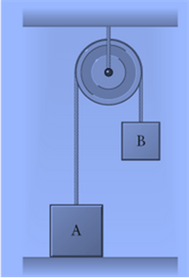
Box A weighs
Box B weighs
Pulley and rope are massless.
Formula Used:
Calculation:
The forces acting on Box A are the tension in the rope, the force due to gravity, and the force the table exerts on box A (also known as the normal force).
The tension in the rope is equal to the weight of box B when box B is at rest.
If the weight of box B is larger than the weight of box A, both boxes start to move-box A moves up, while box B moves down.
Free-body diagram of box A:
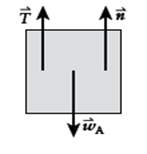
If box A remains at rest, then
If box B weighs
Conclusion:
The force that table exerts on box A if box B weighs
(b)
The force that the table exerts on box A if box B weighs
Answer to Problem 61QAP
The force exerted by table on box A is
Explanation of Solution
Given info:
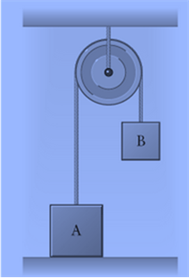
Box A weighs
Box B weighs
Pulley and rope are massless.
Formula Used:
Calculation:
The forces acting on Box A are the tension in the rope, the force due to gravity, and the force the table exerts on box A (also known as the normal force).
The tension in the rope is equal to the weight of box B when box B is at rest.
If the weight of box B is larger than the weight of box A, both boxes start to move-box A moves up, while box B moves down.
Free-body diagram of box A:
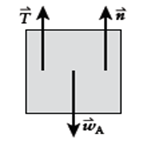
If box A remains at rest, then
If box B weighs
Conclusion:
The force that table exerts on box A if box B weighs
(c)
The force that the table exerts on box A if box B weighs
Answer to Problem 61QAP
The force that table exerts on box A if box B weighs
Explanation of Solution
Given:
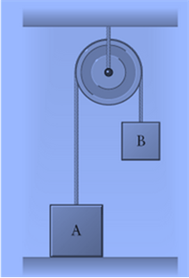
Box A weighs
Box B weighs
Pulley and rope are massless.
Formula Used:
Calculation:
The forces acting on Box A are the tension in the rope, the force due to gravity, and the force the table exerts on box A (also known as the normal force).
The tension in the rope is equal to the weight of box B when box B is at rest.
If the weight of box B is larger than the weight of box A, both boxes start to move-box A moves up, while box B moves down.
.
Free-body diagram of box A:
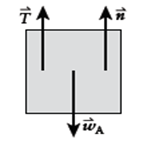
If box A remains at rest, then
If box B weighs more than box A, then we would expect box B to fall down and lift box A off
The table.
Since box A is no longer touching the table, the normal goes to
Conclusion:
The force that table exerts on box A if box B weighs
Want to see more full solutions like this?
Chapter 4 Solutions
COLLEGE PHYSICS
- An oil slick on water is 82.3 nm thick and illuminated by white light incident perpendicular to its surface. What color does the oil appear (what is the most constructively reflected wavelength, in nanometers), given its index of refraction is 1.43? (Assume the index of refraction of water is 1.33.) wavelength color 675 × nm red (1 660 nm)arrow_forwardA 1.50 μF capacitor is charging through a 16.0 Ω resistor using a 15.0 V battery. What will be the current when the capacitor has acquired 1/4 of its maximum charge? Please explain all stepsarrow_forwardIn the circuit shown in the figure (Figure 1), the 6.0 Ω resistor is consuming energy at a rate of 24 J/s when the current through it flows as shown. What are the polarity and emf of the battery E, assuming it has negligible internal resistance? Please explain all steps. I know you need to use the loop rule, but I keep getting the answer wrong.arrow_forward
- If you connect a 1.8 F and a 2.6 F capacitor in series, what will be the equivalent capacitance?arrow_forwardSuppose that a particular heart defibrillator uses a 1.5 x 10-5 Farad capacitor. If it is charged up to a voltage of 7300 volts, how much energy is stored in the capacitor? Give your answer as the number of Joules.arrow_forwardThe voltage difference across an 8.3 nanometer thick cell membrane is 6.5 x 10-5volts. What is the magnitude of the electric field inside this cell membrane? (Assume the field is uniform, and give your answer as the number of Volts per meter... which is the same as the number of Newtons per Coulomb.)arrow_forward
- Three identical capacitors are connected in parallel. When this parallel assembly of capacitors is connected to a 12 volt battery, a total of 3.1 x 10-5 coulombs flows through the battery. What is the capacitance of one individual capacitor? (Give your answer as the number of Farads.)arrow_forwardSuppose you construct your own capacitor by placing two parallel plates at a distance 0.27 meters apart. The plates each have a surface area of 0.64 square meters. What is the capacitance of this setup? (Give your answer as the number of Farads.)arrow_forwardDraw a diagram with the new arrows. No they do not point all towards the center.arrow_forward
- Example In Canada, the Earth has B = 0.5 mŢ, pointing north, 70.0° below the horizontal. a) Find the magnetic force on an oxygen ion (O2) moving due east at 250 m/s b) Compare the |FB| to |FE| due to Earth's fair- weather electric field (150 V/m downward).arrow_forwardFour charges, qa, qb, qa, and qd are fixed at the corners of a square. A charge q that is free to move located at the exact center of the square. Classify the scenarios described according to the force that would be exerted on the center charge q. Assume in each case that q is a positive charge. Do not assume that the fixed charges have equal magnitudes unless the scenario defines such an equality. qa Яс q %b Force is zero Force is to the left Force is to the right Force is undeterminedarrow_forwardCharge qi = -q is located at position (0, d). Charge q = −2q₁ is located at position (d,0). Charge q3 = located at position (2d, 2d). 5qi is y Determine the net electric field Ĕ net at the origin. Enter your expression using ij unit vector notation in terms of the given quantities, the permittivity of free space €0, and exact rational and irrational numbers. d 9₁ d TH net = 92 d d Xarrow_forward
 Principles of Physics: A Calculus-Based TextPhysicsISBN:9781133104261Author:Raymond A. Serway, John W. JewettPublisher:Cengage Learning
Principles of Physics: A Calculus-Based TextPhysicsISBN:9781133104261Author:Raymond A. Serway, John W. JewettPublisher:Cengage Learning Classical Dynamics of Particles and SystemsPhysicsISBN:9780534408961Author:Stephen T. Thornton, Jerry B. MarionPublisher:Cengage Learning
Classical Dynamics of Particles and SystemsPhysicsISBN:9780534408961Author:Stephen T. Thornton, Jerry B. MarionPublisher:Cengage Learning College PhysicsPhysicsISBN:9781305952300Author:Raymond A. Serway, Chris VuillePublisher:Cengage Learning
College PhysicsPhysicsISBN:9781305952300Author:Raymond A. Serway, Chris VuillePublisher:Cengage Learning College PhysicsPhysicsISBN:9781285737027Author:Raymond A. Serway, Chris VuillePublisher:Cengage Learning
College PhysicsPhysicsISBN:9781285737027Author:Raymond A. Serway, Chris VuillePublisher:Cengage Learning College PhysicsPhysicsISBN:9781938168000Author:Paul Peter Urone, Roger HinrichsPublisher:OpenStax College
College PhysicsPhysicsISBN:9781938168000Author:Paul Peter Urone, Roger HinrichsPublisher:OpenStax College An Introduction to Physical SciencePhysicsISBN:9781305079137Author:James Shipman, Jerry D. Wilson, Charles A. Higgins, Omar TorresPublisher:Cengage Learning
An Introduction to Physical SciencePhysicsISBN:9781305079137Author:James Shipman, Jerry D. Wilson, Charles A. Higgins, Omar TorresPublisher:Cengage Learning





